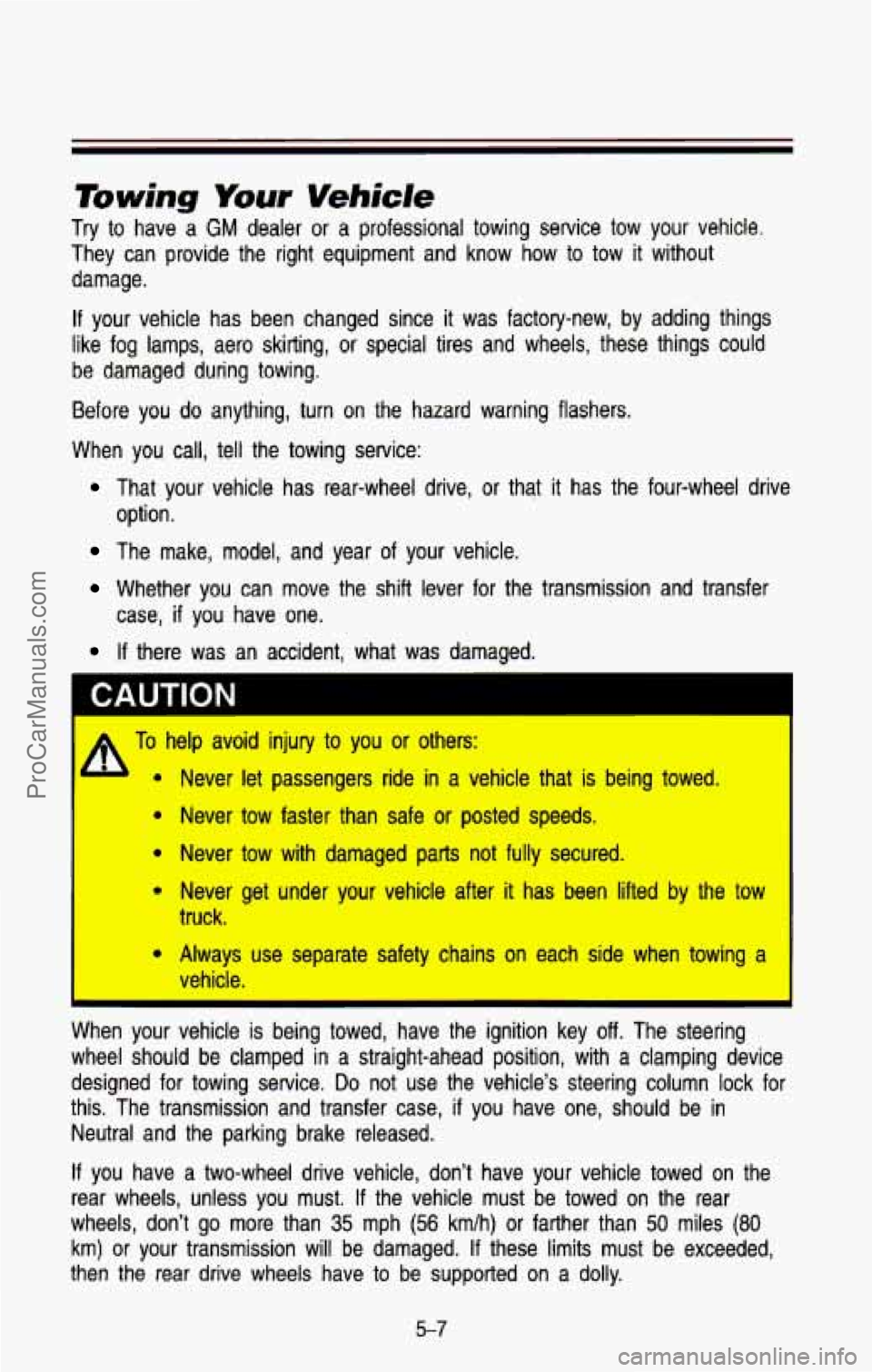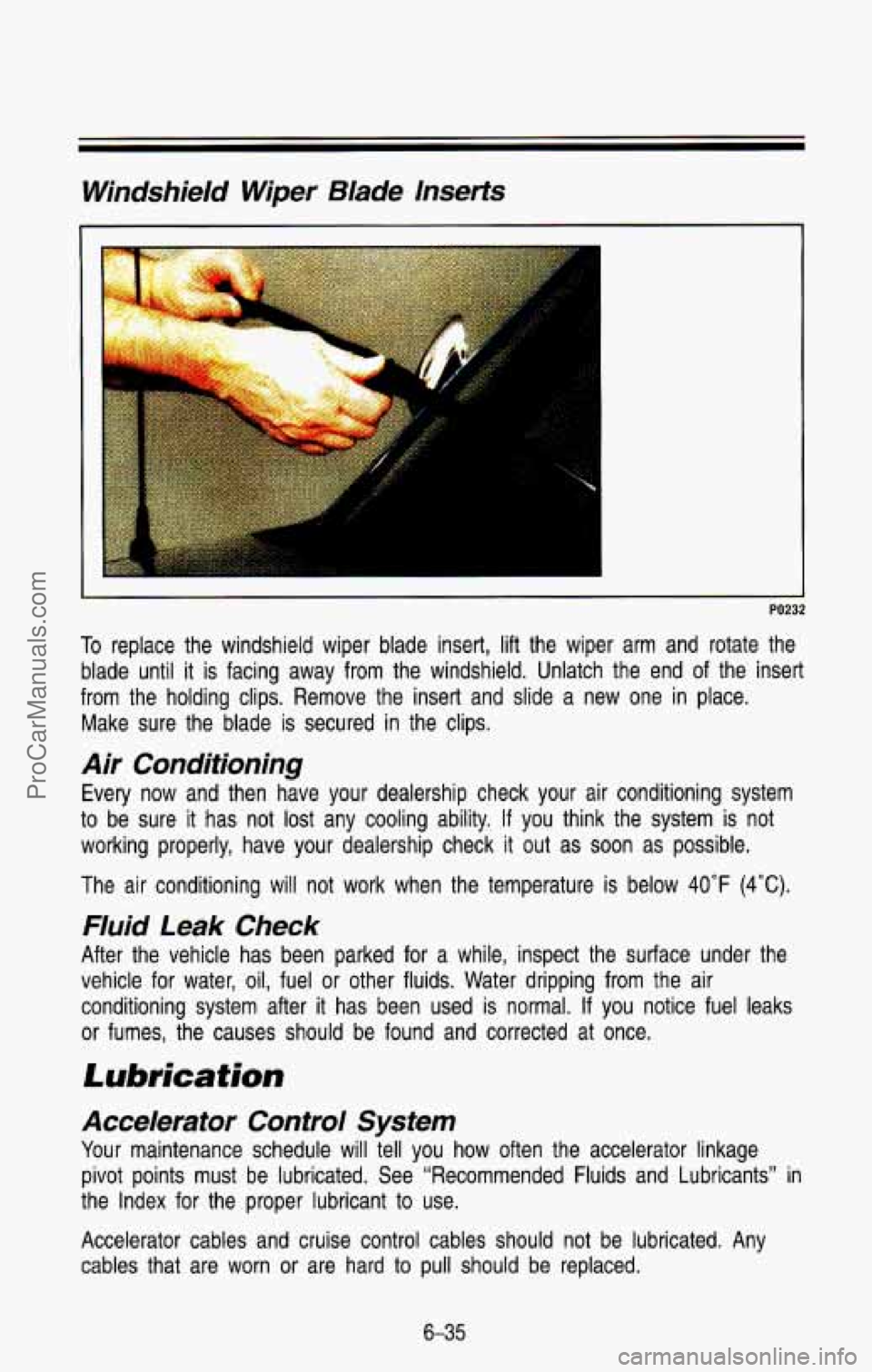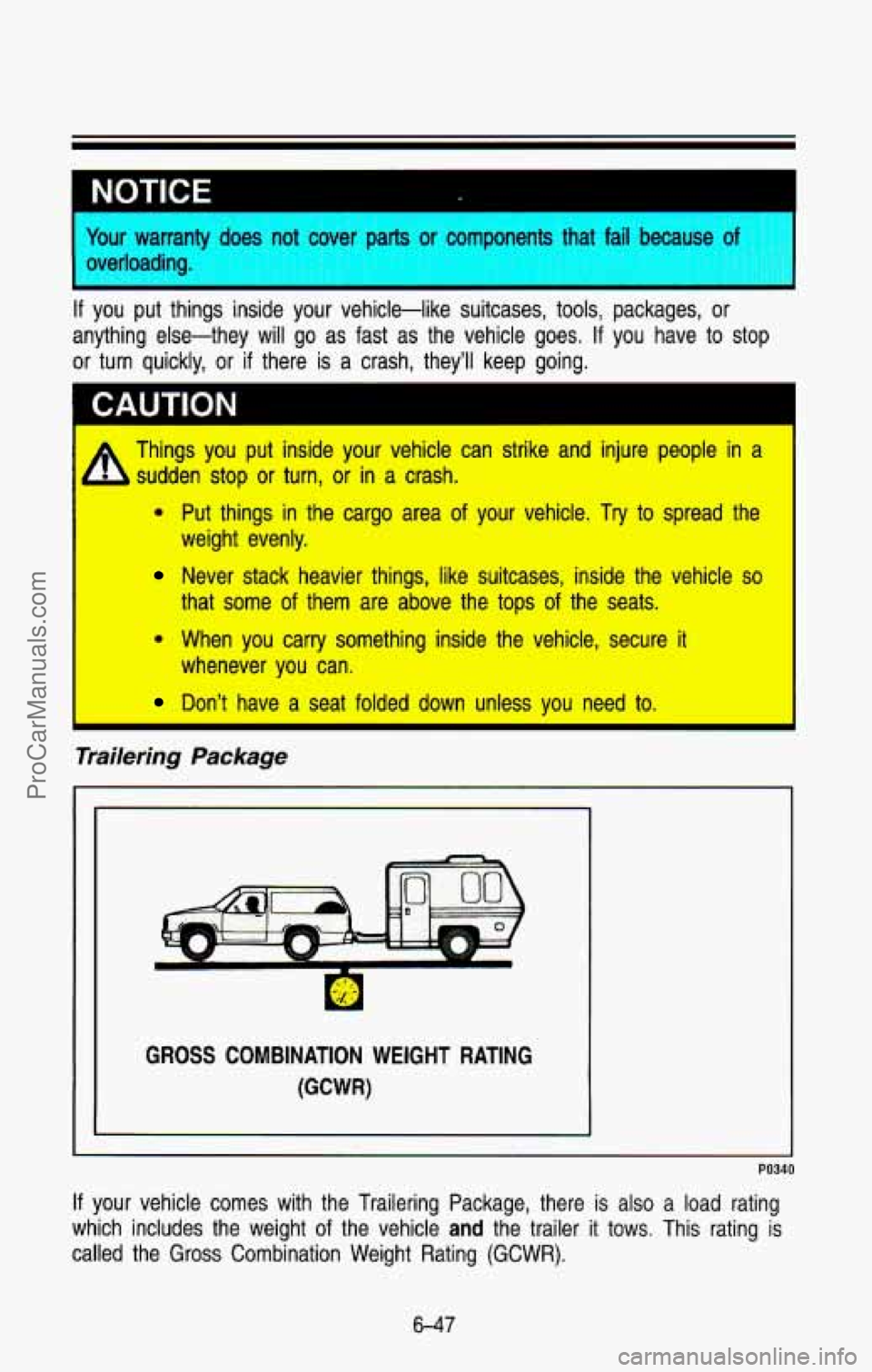Page 228 of 386

I
If you have a rear-most window open and you pull a trailer with \
your
can’t see or smell
CO. It can cause unconsciousness or death (See
“Engine Exhaust” in the Index).
To maximize your safety when towing
a trailer:
- vehicle, carbon monoxide (CO) could come into your vehicle. You
Have the exhaust system inspected for leaks and make
Keep the rear-most windows closed.
If exhaust does come into your vehicle through a window in the
rear or another opening, drive with your front, main heating or
cooling system
on and with the fan on any speed. This will
bring fresh, outside air into your vehicle.
Do not use RECIR
because it only recirculates the air inside your vehicle. See
“Comfort Controls” in the Index.
necessary repairs before starting on your trip.
During your trip, check occasionally to be sure that the load is secure, and
that the lights and any trailer brakes are still working.
Following Distance
Stay at least twice as far behind the vehicle ahead as you would when
driving your vehicle without a trailer. This can help you avoid situations that
require heavy braking and sudden turns.
Passing
You’ll need more passing distance up ahead when you’re towing a tr\
ailer.
And, because you’re
a good deal longer, you’ll need to go much farther
beyond the passed vehicle before you can return to your lane.
Backing Up
Hold the bottom of the steering wheel with one hand. Then, to move the
trailer left, just move your hand to the left.
To move the trailer to the right,
move your hand to the right. Always back up slowly and,
if possible, have
someone guide you.
Making Turns
When you’re turning with a trailer, make wider turns than n\
ormal. Do this so
your trailer wheels won’t strike soft shoulders, curbs, road signs, trees, or
other objects. Avoid jerky or sudden maneuvers. Signal well in advance.
4-61
ProCarManuals.com
Page 238 of 386

Tiwing Your Vehicle
Try to have a GM dealer or a professional towing service tow your vehicle.
They can provide the right equipment and know how to tow
it without
damage.
If your vehicle has been changed since it was factory-new, by adding things
like fog lamps, aero skirting,
or special tires and wheels, these things could
be damaged during towing.
Before you
do anything, turn on the hazard warning flashers.
When you call, tell the towing service:
That your vehicle has rear-wheel drive, or that it has the four-wheel drive
option.
The make, model, and year of your vehicle.
Whether you can move the shift lever for the transmission and \
transfer
If there was an accident, what was damaged.
case,
if you have one.
CAUTION I
To help avoid
injury to you or others:
A 9 Never let passengers ride in a vehicle that is being towed.
e Never tow faster than safe or posted speeds.
e Never tow with damaged parts not fully secured.
Never get under your vehicle after it has been lifted by the tow
truck.
* Always use separate safety chains on each side when towing a
vehicle.
When your vehicle is being towed, have the ignition key off. The steering
wheel should be clamped in a straight-ahead position, with a clamping device
designed for towing service.
Do not use the vehicle’s steering column lock for
this. The transmission and transfer case,
if you have one, should be in
Neutral and the parking brake released.
If you have a two-wheel drive vehicle, don’t have your vehicle \
towed on the
rear wheels, unless you must.
If the vehicle must be towed on the rear
wheels, don’t
go more than 35 mph (56 kmlh) or farther than 50 miles (80
km) or your transmission will be damaged. If these limits must be exceeded,
then the rear drive wheels have to be supported on a dolly.
5-7
ProCarManuals.com
Page 250 of 386
K2135
If your utility model has a jack cover, turn the wing nut counterclockwise to
take it off, then take the cover off.
". .. .
K214
To take the jack out, turn the wing nut counterclockwise and take it and the
retainer
off. Take the jack and storage box out and take the tools out of the
box.
Your vehicle may have a pair
of emergency gloves secured to the jack. You
can use them when changing the tire, or during other emergency situations.
Remember to replace them with the jack,
so you will have them handy if
needed later.
5-1 9
ProCarManuals.com
Page 261 of 386
Problems on the Road
Storing the Jack and Tire
Storhg the Jack
Put the tools into the storage box and close it tightly, Fit the storage box into
the bracket with the bolt through the box. Put the jack onto the
box. Be sure
the jack points in the right direction as shown for your mode\
l. Secure the
emergency gloves,
if your vehicle has them, to the jack using the provided
strap.
Slide the retainer over the bolt onto the jack and put the w\
ing nut on. Turn
the nut clockwise until it is tight against the retainer.
Replace the jack storage cover,
if your vehicle has one, by simply reversing
the removal procedure described earlier.
Storing the Tire
Be sure the J-bolt is hooked properly for your model or tire size as shown.
n
I - BOLT
J - BOLT
,ADAPTER
ADAPTER
NOTE: Use lower hole
for 8 lug rim only.
L
PO21 3
If you have a wagon model, use these locations.
5-30
ProCarManuals.com
Page 300 of 386

Windshield Wiper Blade lnserfs
J
PO232
To replace the windshield wiper blade insert, lift the wiper arm and rotate the
blade until
it is facing away from the windshield. Unlatch the end of the insert
from the holding clips. Remove the insert and slide a new one in place,
Make sure the blade
is secured in the clips.
Air Conditioning
Every now and then have your dealership check your air conditioning system
to be sure it has not lost any cooling ability,
If you think the system is not
working properly, have your dealership check
it out as soon as possible.
The air conditioning will not work when the temperature is below
40°F (4°C).
Fluid Leak Check
After the vehicle has been parked for a while, inspect the su\
rface under the
vehicle for water, oil, fuel or other fluids. Water dripping from the air
conditioning system after
it has been used is normal. If you notice fuel leaks
or fumes, the causes should be found and corrected at once.
Lubrication
Accelerator Control System
Your maintenance schedule will tell you how often the accelerator linkage
pivot points must be lubricated. See “Recommended Fluids and Lubric\
ants”
in
the Index for the proper lubricant to use.
Accelerator cables and cruise control cables should not be lubr\
icated. Any
cables that are worn or are hard to pull
should be replaced.
6-35
ProCarManuals.com
Page 312 of 386

Your warranty does not r-rer parts or co ~~ ronents that fail because -
If you put things inside your vehicle-like suitmes, LWWIY, pac;Kages, or
anything else-they will go as fast as the vehicle goes. If you have to stop
or turn quickly, or if there is a crash, they’ll keep going.
I
Things you put inside your vehicle can strike and injure people in a
, sudden stop or turn, or in a crash.
9 Put things in the cargo area of your vehicle. Try to spread the
Never stack heavier things, like suitcases, inside the vehicle so
weight evenly.
that some
of them are above the tops of the seats.
When you carry something inside the vehicle, secure it
whenever you can. I
I Don’t have a seat folded down unless you need to. I
Trailering Package
GROSS COMBINATION WEIGHT RATING
(GCWR)
PO340
If your vehicle comes with the Trailering Package, there is al\
so a load rating
which includes the weight of the vehicle
and the trailer it tows. This rating is
called the
Gross Combination Weight Rating (GCWR).
6-47
ProCarManuals.com
Page:
< prev 1-8 9-16 17-24